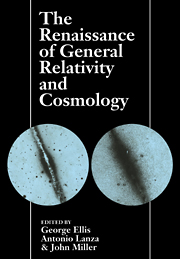 The Renaissance of General Relativity and Cosmology
The Renaissance of General Relativity and Cosmology Book contents
- Frontmatter
- Contents
- Author Addresses
- 1 Introduction
- 2 Exact and inexact solutions of the Einstein field equations
- 3 Inertial forces in general relativity
- 4 Relativistic radiation hydrodynamics: a covariant theory of flux-limiters
- 5 Relativistic gravitational collapse
- 6 The cosmic censorship hypothesis
- 7 The Kerr metric: a gateway to the roots of gravity?
- 8 Galactic astronomy since 1950
- 9 Galaxy distribution functions
- 10 Nonlinear galaxy clustering
- 11 Quasars: progress and prospects
- 12 Decaying neutrinos in astronomy and cosmology
- 13 Cosmological principles
- 14 Anisotropic and inhomogeneous cosmologies
- 15 Mach's principle and isotropic singularities
- 16 Implications of superconductivity in cosmic string theory
- 17 The formation and evaporation of primordial black holes
- 18 Evaporation of two dimensional black holes
- 19 Topology and topology change in general relativity
- 20 Decoherence of the cluttered quantum vacuum
- 21 Quantum non-locality and complex reality
- 22 The different levels of connections between science and objective reality
14 - Anisotropic and inhomogeneous cosmologies
Published online by Cambridge University Press: 15 December 2009
- Frontmatter
- Contents
- Author Addresses
- 1 Introduction
- 2 Exact and inexact solutions of the Einstein field equations
- 3 Inertial forces in general relativity
- 4 Relativistic radiation hydrodynamics: a covariant theory of flux-limiters
- 5 Relativistic gravitational collapse
- 6 The cosmic censorship hypothesis
- 7 The Kerr metric: a gateway to the roots of gravity?
- 8 Galactic astronomy since 1950
- 9 Galaxy distribution functions
- 10 Nonlinear galaxy clustering
- 11 Quasars: progress and prospects
- 12 Decaying neutrinos in astronomy and cosmology
- 13 Cosmological principles
- 14 Anisotropic and inhomogeneous cosmologies
- 15 Mach's principle and isotropic singularities
- 16 Implications of superconductivity in cosmic string theory
- 17 The formation and evaporation of primordial black holes
- 18 Evaporation of two dimensional black holes
- 19 Topology and topology change in general relativity
- 20 Decoherence of the cluttered quantum vacuum
- 21 Quantum non-locality and complex reality
- 22 The different levels of connections between science and objective reality
Summary
INTRODUCTION
My first impressions of Dennis Sciama came from a short introductory astrophysics course he gave to undergraduates in 1964. Then in 1966-7 I took his Cambridge Part III course in relativity, in which he charitably ignored my inadvertent use of Euclidean signature in the examination (an error I spotted just at the very end of the allowed time) and gave me a good mark. In both these courses he showed the qualities of enthusiasm and encouragement of students with which I was to become more familiar later in 1967 when I began as a research student. A project on stellar structure had taught me that I did not want to work on that, and I began under Dennis with the idea of looking at galaxy formation. However, by sharing an office with John Stewart I came to read John's paper with George Ellis (Stewart and Ellis, 1968) and its antecedent (Ellis, 1967) and developed an interest in relativistic cosmological models, which led to George becoming my second supervisor.
I was still in Sciama's group, and I learnt a lot from the tea-table conversations, which seemed to cover all of general relativity and astrophysics. Dennis taught us by example that the field should not be sub—divided into mathematics and physics, or cosmological and galactic and stellar, but that one needed to know about all those things to do really good work.
- Type
- Chapter
- Information
- The Renaissance of General Relativity and CosmologyA Survey to Celebrate the 65th Birthday of Dennis Sciama, pp. 213 - 233Publisher: Cambridge University PressPrint publication year: 1993
- 4
- Cited by


